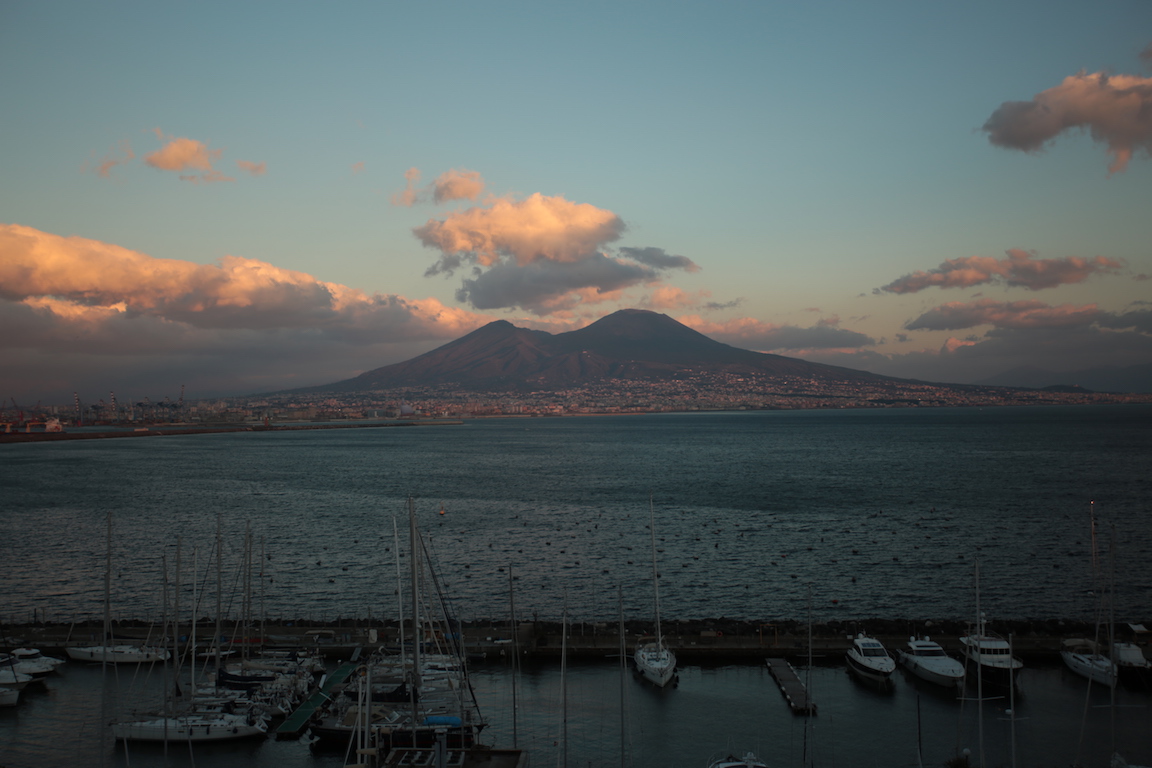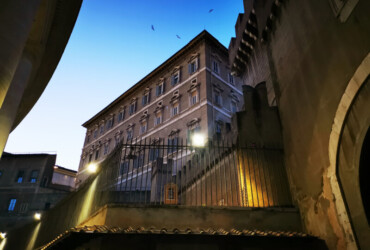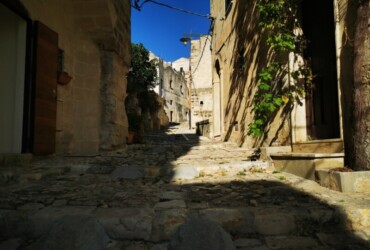At the beginning of April 2017, I was (back) in Naples. In this post I would like to tell you about my trip to Naples: just over a day to discover the city from the industrial archaeology to the historical centre, passing through its charming historic centre.
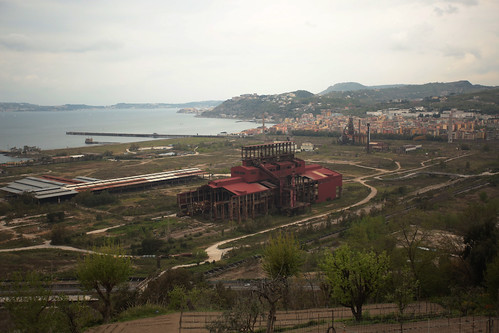 Let’s start from the most distant places from the historic centre, in particular from Viale Manzoni and the view it offers on Bagnoli and the Italsider: on the slopes of the Posillipo hill, the Bagnoli district overlooks the Bay of Naples and the island of Nisida. Here there are the Italsider’s plants, now abandoned and catalogued as industrial archaeology. Famous is the pontoon of Bagnoli: about 2 kilometres long, ends in the middle of the sea and was used to transport the fossil carbon necessary for the operation of industrial plants.
Let’s start from the most distant places from the historic centre, in particular from Viale Manzoni and the view it offers on Bagnoli and the Italsider: on the slopes of the Posillipo hill, the Bagnoli district overlooks the Bay of Naples and the island of Nisida. Here there are the Italsider’s plants, now abandoned and catalogued as industrial archaeology. Famous is the pontoon of Bagnoli: about 2 kilometres long, ends in the middle of the sea and was used to transport the fossil carbon necessary for the operation of industrial plants.
 Today it is a pedestrian pier, used by the inhabitants of the area as a place for a walk or to go jogging. Not far away we find the Parco della Rimembranza: also from here you have a beautiful view of the Bay of Naples and the island of Nisida! The latter is a small island that “so much island is no longer” because there is, today, a strip of land (with an adjacent road) that connects it to the mainland. The Italian music also mentions the island of Nisida:
Today it is a pedestrian pier, used by the inhabitants of the area as a place for a walk or to go jogging. Not far away we find the Parco della Rimembranza: also from here you have a beautiful view of the Bay of Naples and the island of Nisida! The latter is a small island that “so much island is no longer” because there is, today, a strip of land (with an adjacent road) that connects it to the mainland. The Italian music also mentions the island of Nisida:
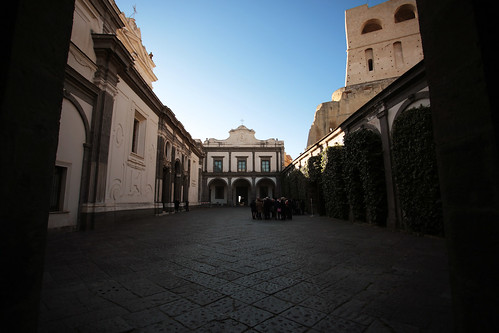 Bennato talks about it in one of his song saying that “Nisida is an island and nobody knows”. It is part of the Flegrean Islands, once home to the Aeronautical Academy (which is now located in Pozzuoli) and unfortunately, it is not open to the public as it is divided between a military garrison and a juvenile prison. We approach the real centre by going to the Certosa di San Martino, which is located at Vomero just next to Castel Sant’Elmo. In Baroque style, the Charterhouse is one of the most essential religious monumental complexes in Naples.
Bennato talks about it in one of his song saying that “Nisida is an island and nobody knows”. It is part of the Flegrean Islands, once home to the Aeronautical Academy (which is now located in Pozzuoli) and unfortunately, it is not open to the public as it is divided between a military garrison and a juvenile prison. We approach the real centre by going to the Certosa di San Martino, which is located at Vomero just next to Castel Sant’Elmo. In Baroque style, the Charterhouse is one of the most essential religious monumental complexes in Naples.
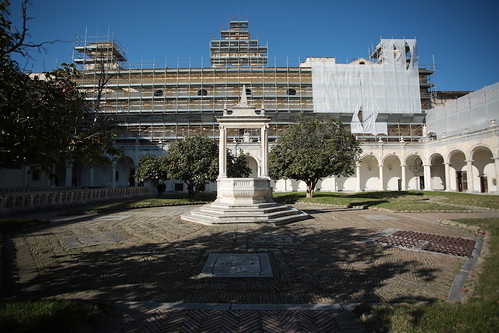 In temporal order, this is the second Certosa of Campania (after that of San Lorenzo a Padula). After the unification of Italy, when it returned among the suppressed ecclesiastical properties, it became a national monument, and since 1866 there is also the National Museum of San Martino, created to tell the artistic and cultural history of Naples (a fascinating story, I add). I strongly suggest you look out from the terrace (indeed, terraces) because the view over the bay of Naples is breathtaking and do not forget the cloister “of the skulls”, very particular place and visiting will understand why.
In temporal order, this is the second Certosa of Campania (after that of San Lorenzo a Padula). After the unification of Italy, when it returned among the suppressed ecclesiastical properties, it became a national monument, and since 1866 there is also the National Museum of San Martino, created to tell the artistic and cultural history of Naples (a fascinating story, I add). I strongly suggest you look out from the terrace (indeed, terraces) because the view over the bay of Naples is breathtaking and do not forget the cloister “of the skulls”, very particular place and visiting will understand why.
 The admission ticket costs 6 euros (3 euros the reduced card), and admission is free every first Sunday of the month. In Piazza del Plebiscito, in front of the Basilica of San Francesco di Paola, there is the the Royal
The admission ticket costs 6 euros (3 euros the reduced card), and admission is free every first Sunday of the month. In Piazza del Plebiscito, in front of the Basilica of San Francesco di Paola, there is the the Royal
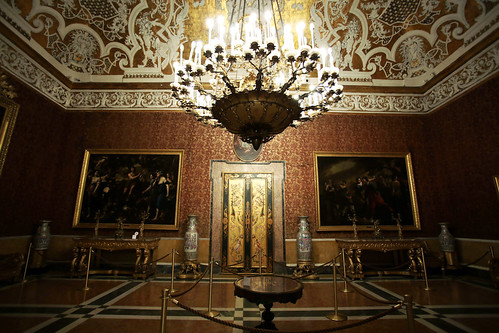 Palace of Naples. This palace was the residence of the Spanish viceroys for more than one hundred and fifty years, of the Bourbons from 1734 to 1861 and of the Savoy after the unification of Italy. In 1919 it was sold to state property and today is the seat of the national library and museum centre (in particular the royal apartments). The interior is, as one would expect from a royal palace, something beautiful and unique. The admission ticket costs 4 euros (3 euros reduced), including the audio guide,
Palace of Naples. This palace was the residence of the Spanish viceroys for more than one hundred and fifty years, of the Bourbons from 1734 to 1861 and of the Savoy after the unification of Italy. In 1919 it was sold to state property and today is the seat of the national library and museum centre (in particular the royal apartments). The interior is, as one would expect from a royal palace, something beautiful and unique. The admission ticket costs 4 euros (3 euros reduced), including the audio guide,
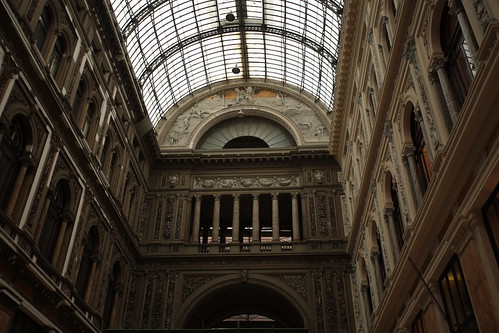 and the first Sunday of the month admission is free. Not far away, a few dozen meters away, is the well known Galleria Umberto I, a commercial gallery built in Naples between 1887 and 1890. The main entrance is the one facing Via San Carlo, consisting of an exedra façade. The very high glass and iron vault, designed by Paolo Boubée, is undoubtedly the “symbol” that we all remember of this gallery (many remember it, probably
and the first Sunday of the month admission is free. Not far away, a few dozen meters away, is the well known Galleria Umberto I, a commercial gallery built in Naples between 1887 and 1890. The main entrance is the one facing Via San Carlo, consisting of an exedra façade. The very high glass and iron vault, designed by Paolo Boubée, is undoubtedly the “symbol” that we all remember of this gallery (many remember it, probably
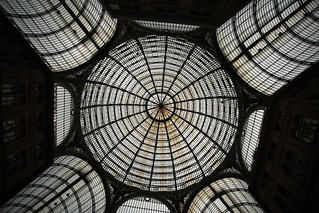 because it’s similar to the vault of the Vittorio Emanuele Gallery in Milan). Because this dome fits perfectly into the structure, the builders have played a lot on the relationship between the masonry bearing formations and the iron structures. On the dome drum, you can see the Star of David: this is because the gallery is the historical seat of the Neapolitan masonry, in particular of the Masonic lodge of the Grand Orient of Italy. The star of David, in this case, also represents the symbol of masonry because it was formed with two inverted triangles. To get from the gallery to the alleys of the historic centre of Naples is a moment.
because it’s similar to the vault of the Vittorio Emanuele Gallery in Milan). Because this dome fits perfectly into the structure, the builders have played a lot on the relationship between the masonry bearing formations and the iron structures. On the dome drum, you can see the Star of David: this is because the gallery is the historical seat of the Neapolitan masonry, in particular of the Masonic lodge of the Grand Orient of Italy. The star of David, in this case, also represents the symbol of masonry because it was formed with two inverted triangles. To get from the gallery to the alleys of the historic centre of Naples is a moment.
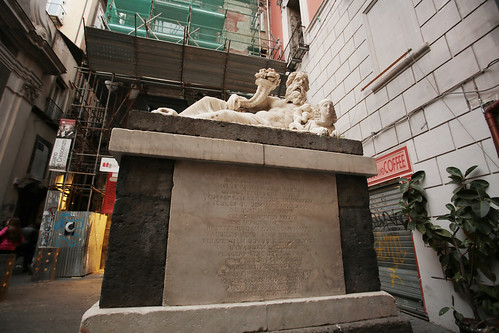 Why walk through the lanes of the historic centre? First of all, because I believe they can tell the story of the city better and, secondly because since 1995 it is on the list of UNESCO’s heritage assets. The area of the historic centre, the largest in Europe, still tells in the best way 27 centuries of history. It’s uniqueness? Being still intact and the fact that, walking through its narrow streets, you can even see the road layout dating back to the Greek era. Right in the historic centre, you will find the Cappella di San Severo, where there is the Veiled Christ (if you’ve never seen it I recommend you to go as soon as possible) and also the different visit path of the “underground Naples”
Why walk through the lanes of the historic centre? First of all, because I believe they can tell the story of the city better and, secondly because since 1995 it is on the list of UNESCO’s heritage assets. The area of the historic centre, the largest in Europe, still tells in the best way 27 centuries of history. It’s uniqueness? Being still intact and the fact that, walking through its narrow streets, you can even see the road layout dating back to the Greek era. Right in the historic centre, you will find the Cappella di San Severo, where there is the Veiled Christ (if you’ve never seen it I recommend you to go as soon as possible) and also the different visit path of the “underground Naples”
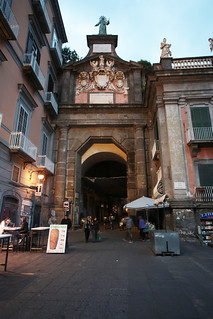 A short walk to San Gregorio Armeno is always a must (although this time we arrived that the shops were closing). To get out of the historic centre, I suggest you go through the “street of booksellers” and Port’Alba:
A short walk to San Gregorio Armeno is always a must (although this time we arrived that the shops were closing). To get out of the historic centre, I suggest you go through the “street of booksellers” and Port’Alba:
 overlooking Piazza Dante, so if you love shopping you can take via Toledo for a ride through the shops.
overlooking Piazza Dante, so if you love shopping you can take via Toledo for a ride through the shops.
How to end the day? If it’s sunset time, I suggest you go through Castel dell’Ovo, the oldest castle in the city: the entrance is always free (there is not even the ticket office). The castle was built in the Norman period, but the original appearance has (unfortunately) been lost over time due to successive reconstructions and modifications of subsequent historical periods. Located practically at the beginning of the promenade and attached to the Santa Lucia district, today it is used as a location for events and exhibitions. A sunset seen from here, overlooking the bay, is one of the best ways to end a day (before going out to eat, of course!)

A trip to Naples: between industrial archaeology and the historic centre
